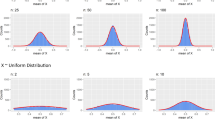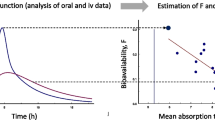Abstract
The application of maximum entropy to the calculation of drug absorption rates was introduced in an earlier paper. Here it is developed further, and the whole procedure is presented as a problem in scientific inference to be solved using Bayes' theorem. Blood samples do not need to be taken at equally spaced intervals, and no smoothing, interpolation, extrapolation, or other preprocessing of the data is necessary. The resulting input rate estimates are smooth and physiologically realistic, even with noisy data, and their accuracy is quantified. Derived quantities such as the proportion of the dose absorbed, and the mean and median absorption times, are also obtained, together with their error estimates. There are no arbitrarily valued parameters in the analysis, and no specific functional form, such as an exponential or polynomial, is assumed for the input rate functions.
Similar content being viewed by others
Explore related subjects
Discover the latest articles and news from researchers in related subjects, suggested using machine learning.References
M. K. Charter and S. F. Gull. Maximum entropy and its application to the calculation of drug absorption rates.J. Pharmacokin. Biopharm. 15:645–655 (1987).
S. F. Gull. Developments in maximum entropy data analysis. In J. Skilling, (ed.),Maximum Entropy and Bayesian Methods, Cambridge 1988. Kluwer, Dordrecht, The Netherlands, 1989, pp. 53–71.
R. T. Cox. Probability, frequency and reasonable expectation.Am. J. Physics 14:1–13 (1946).
J. Skilling. Classic maximum entropy. In J. Skilling (ed.),Maximum Entropy and Bayesian Methods, Cambridge 1988, Kluwer, Dordrecht, The Netherlands, 1989, pp. 45–52.
J. Skilling. Quantified maximum entropy. In P. F. Fougère (ed.),Maximum Entropy and Bayesian Methods, Dartmouth College 1989, Kluwer, Dordrecht, The Netherlands, 1990, pp. 341–350.
S. F. Gull and J. Skilling.Quantified Maximum Entropy “MemSys3”Users' Manual Maximum Entropy Data Consultants, 33 North End, Meldreth, Royston, Herts., SG8 6NR, U.K., 1989.
L. F. Prescott. Kinetics and metabolism of paracetamol and phenacetin.Br. J. Clin. Pharmacol. 10:2915–2985 (1980).
D. J. Cutler. Theory of the mean absorption time, an adjunct to conventional bioavailability studies.J. Pharm. Pharmacol. 30:476–478 (1978).
M. S. Roberts and M. Rowland. A dispersion model of hepatic elimination: 1. Formulation of the model and bolus considerations.J. Pharmacokin. Biopharm. 14:227–260 (1986).
Author information
Authors and Affiliations
Rights and permissions
About this article
Cite this article
Charter, M.K., Gull, S.F. Maximum entropy and drug absorption. Journal of Pharmacokinetics and Biopharmaceutics 19, 497–520 (1991). https://doi.org/10.1007/BF01062960
Received:
Revised:
Published:
Issue Date:
DOI: https://doi.org/10.1007/BF01062960




